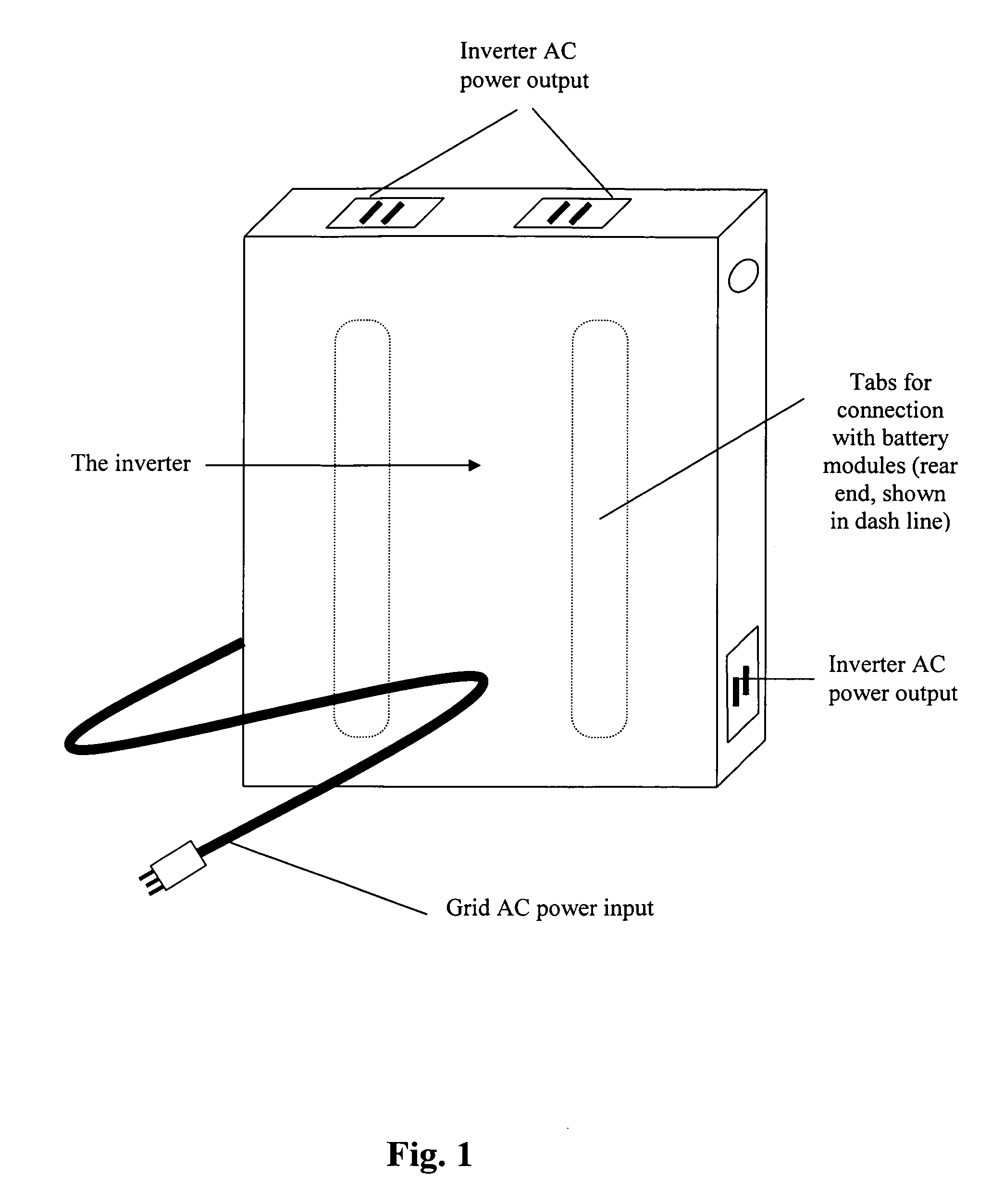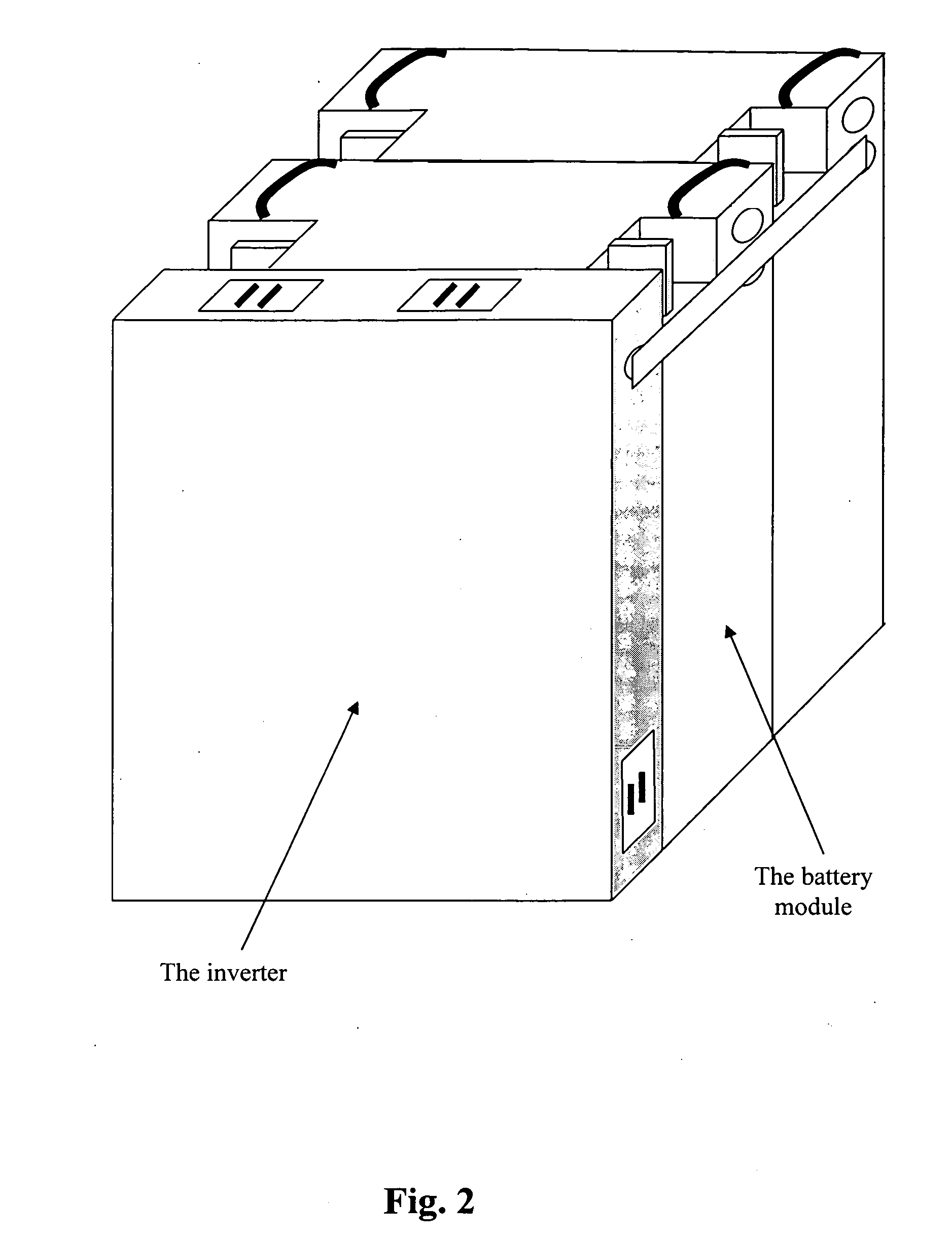Multipurpose portable storage and supply system
- Summary
- Abstract
- Description
- Claims
- Application Information
AI Technical Summary
Benefits of technology
Problems solved by technology
Method used
Image
Examples
example 1
AC Discharge, Recharged with AC and DC Power Sources
[0040]In the present example, the system configuration is indicated in FIG. 5(a). While discharging the system, the low voltage cut-off is controlled by the inverter which is set to be 11V. This system configuration is good for applications such as camping, power source for lap top . . . etc when an AC power source is needed.
[0041]Case I. AC Discharge with AC Charge Before Cut-Off Limit of the Inverter is Reached:
[0042]As shown in FIG. 5(b), before AC discharge is complete, if an AC grid power source is provided, the AC device function will not be affected while the power source is switched from battery to grid power. Meanwhile, the battery module is under the recharging condition when grid AC power is present. The system is under charging until a high voltage limit of 14.6V is reached.
[0043]Case 2. AC Discharge with AC Charge After Cut-Off Limit of the Inverter is Reached:
[0044]Again, as configured in FIG. 5(b), when AC discharge ...
example 2
DC Discharge, Recharged with AC and DC Power Sources
[0053]In the present example, the system configuration is indicated in FIG. 3 as being only one battery module, is sufficient for being a DC power source. While discharging the system, the low voltage cut-off is controlled by the battery module which is set to be VBL=2.0. This stand alone battery module is good for cordless applications such as a DC vacuum cleaner, a lawn mower, a vehicle battery jumper . . . etc, when a DC power source is needed.
[0054]Case I. DC Discharge with AC Charge Before Cut-Off Limit of the Battery Module is Reached:
[0055]Before DC discharge is complete, if the battery module is placed in the system and an AC grid power source is provided, as shown in FIG. 6(a), the battery module will be under-charging from both the AC grid power source at the same time with another battery module that was not subjected to earlier utilization. This charging process proceeds until a high voltage limit of the inverter (VH, 1...
example 3
AC / DC Discharge with AC / DC Charge After Cut-Off Limit of the Battery Module is Reached:
[0068]In the present example, one of the most complicated cases is analyzed. This case is simultaneous discharge of AC and DC devices and the complete discharge of the battery module. The configuration of the whole system is shown in FIG. 7. When AC and DC devices are all connected to the system as shown in FIG. 7, the AC device will be cut-off by the inverter first followed by the DC device being cut-off by the battery module. Under such condition, if both AC and DC power sources are provided, the AC device will be powered by the grid AC power and the battery module will be recharged by both the grid AC power and the solar panel. It should be noted that one of the relays (or all, depending on how deep the discharge is) of the battery modules that met the low voltage cut-off are resumed manually before normal charging. When the relay of the battery module is resumed, the battery module is under-ch...
PUM
 Login to View More
Login to View More Abstract
Description
Claims
Application Information
 Login to View More
Login to View More - R&D Engineer
- R&D Manager
- IP Professional
- Industry Leading Data Capabilities
- Powerful AI technology
- Patent DNA Extraction
Browse by: Latest US Patents, China's latest patents, Technical Efficacy Thesaurus, Application Domain, Technology Topic, Popular Technical Reports.
© 2024 PatSnap. All rights reserved.Legal|Privacy policy|Modern Slavery Act Transparency Statement|Sitemap|About US| Contact US: help@patsnap.com










